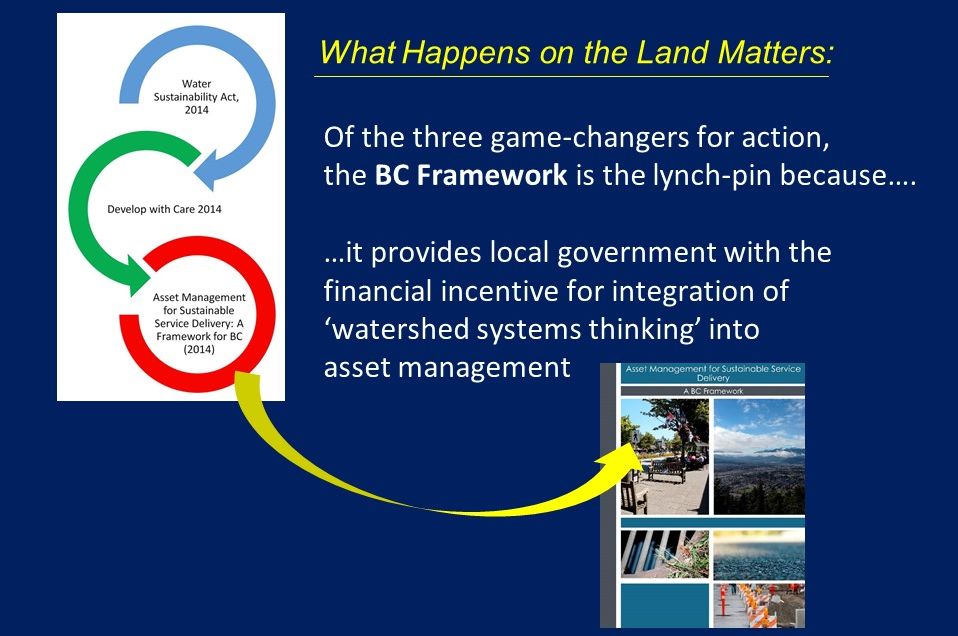FLOWnGROW WORKSHOP: “The BC Framework is the lynch-pin for Sustainable Watershed Systems because it provides local governments with a financial incentive,” stated Kim Stephens
Note to Reader:
Branding of Sustainable Watershed Systems commenced in November 2015 with release of Beyond the Guidebook 2015 by the Partnership for Water Sustainability in BC. At the FLOWnGROW workshop, Kim Stephens (Partnership Executive Director) introduced an Okanagan audience when he delivered an overview presentation on how the concept is an extension of Asset Management for Sustainable Service Delivery: A BC Framework.
Asset Management for Sustainable Service Delivery: A BC Framework
“Local governments are rising to the challenges posed by a changing climate and urban growth. 2003, 2009 and 2015 were teachable years. Droughts, forest fires, wind storms and floods became catalysts for action,” wrote Kim Stephens in an Op-Ed published by the Vancouver Sun newspaper in October 2016.
A Game-Changer
“No longer is asset management only about hard engineered assets – watermains, sewers, roads,” continued Kim Stephens.
“ Already facing a $200 billion challenge for renewal of hard infrastructure, Asset Management for Sustainable Service Delivery: A BC Framework provides a financial driver for local governments to integrate watershed systems thinking and climate adaptation into asset management.”
Already facing a $200 billion challenge for renewal of hard infrastructure, Asset Management for Sustainable Service Delivery: A BC Framework provides a financial driver for local governments to integrate watershed systems thinking and climate adaptation into asset management.”
“It connects directly to asset management requirements for obtaining infrastructure grants – making it a game-changer.”
“Sustainable Watershed Systems, through Asset Management describes a ‘whole-system, water balance’ approach to community development and infrastructure servicing.”
Beyond the Guidebook 2015
“ Beyond the Guidebook 2015: Moving Towards “Sustainable Watershed Systems, through Asset Management initiated the branding of watersheds as infrastructure assets,” states Kim Stephens.
Beyond the Guidebook 2015: Moving Towards “Sustainable Watershed Systems, through Asset Management initiated the branding of watersheds as infrastructure assets,” states Kim Stephens.
“The pathways by which rainfall reaches streams are the assets, and these provide Water Balance Services. Protect the integrity of these pathways. Mimic the natural water balance. Sustain flow in urban streams.”
To Learn More:
Click on the image below to watch the YouTube video of Kim Stephens explaining Sustainable Watershed Systems at the FLOWnGROW workshop.
Sustainable Watershed Systems,
through Asset Management
 Released in September 2016, Sustainable Watershed Systems: Primer on Application of Ecosystem-based Understanding in the Georgia Basin connects past and current research.
Released in September 2016, Sustainable Watershed Systems: Primer on Application of Ecosystem-based Understanding in the Georgia Basin connects past and current research.
It explains why “restoring the water balance” is key to achieving a water-resilient future and restoring aquatic habitat in urban areas.
Getting to Step Three on the Asset Management Continuum
“David Allen put a lot of thought into this sound-bite: the local of local government is to deliver services, and achieving sustainable service delivery is the end goal of asset management,” stated Kim Stephens at FLOWnGROW.
“(Until recently) people did not think in terms of sustainable service delivery. The BC Framework evolved through a consensus process.”
“Over the past year, we have begun to frame where we want to get to in British Columbia in terms of sustainable watershed systems.”
“We are saying it is a three-step process. If you don’t already have an asset management plan, then you cannot make that leap all the way to Step Three.”
“Where we are at now is that local governments, through the granting process, are being encourage to move forward with Steps One and Two.”
“What the Partnership is trying to do right now is to get them ready in terms of where they need to be a couple of years down the road. The game-changer is the BC Framework.”
To Learn More:
Download Sustainable Watershed Systems: Mimic the Natural Water Balance to Protect Environmental Flows in Urban Creeks to view a PDF copy of the PowerPoint presentation by Kim Stephens.




